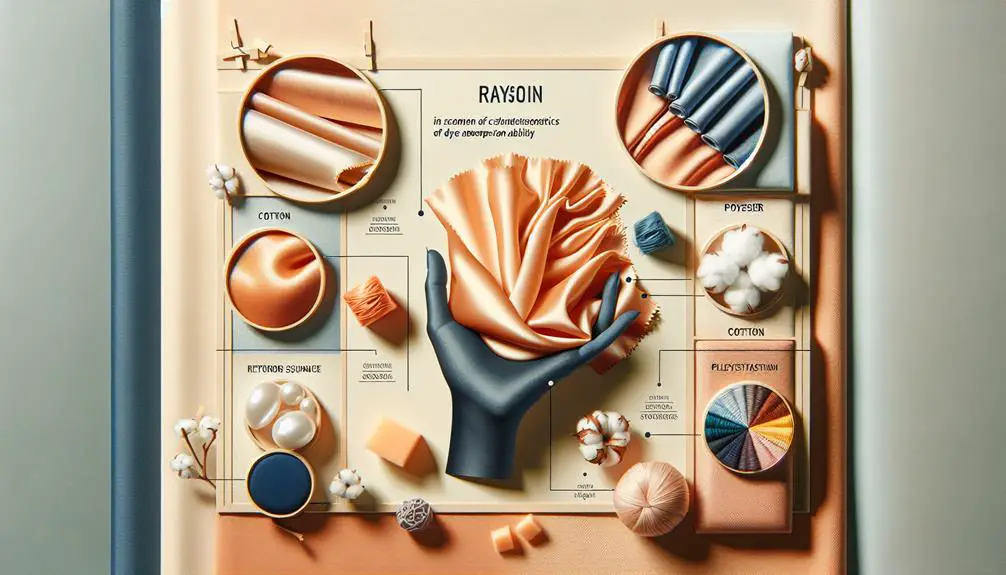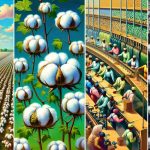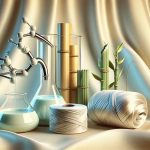I've found that rayon is quite an interesting fabric with a luxurious feel, much like silk. It's extracted from cellulose, which makes it a man-made fiber, but it successfully mimics natural fibers. This material has an excellent drape and is more breathable and moisture-absorbent than polyester. Rayon is also cooler to wear in hot weather compared to many other fabrics, making it an excellent choice for summer clothes. Caring for rayon can be a bit tricky since it requires gentle handling to avoid shrinkage. There's quite a bit more to discover about how rayon compares to other textiles.
Table of Contents
Key Takeaways
- Rayon has a luxurious appearance and feel, closely resembling silk.
- It is highly absorbent, making it cool and comfortable in warm weather.
- Offers versatile textures, enhancing its suitability for various fashion designs.
- Rayon is lightweight, contributing to its comfort and suitability for delicate draping.
- It is more breathable and moisture-absorbent than synthetic fibers like polyester.
Origins and Production
Rayon was first developed in the late 1800s by French chemist Hilaire Bernigaud as a cheaper alternative to silk. This innovative material quickly gained traction due to its luxurious appearance and affordability. The journey to creating rayon fibers begins with the extraction of cellulose, usually from wood pulp. This raw material is key, as it's both renewable and readily available, making rayon an attractive option for many.
The core of the production process involves dissolving this cellulose in chemicals to form a viscous solution. This solution is then pushed through spinnerets, tiny holes that shape the solution into fine threads. Once extruded, the threads are solidified by being submerged in a chemical bath that reconstitutes the cellulose into fiber form.
After these threads, now rayon fibers, are formed, they undergo various finishing processes to enhance their qualities, such as washing, cutting, and drying. These steps are crucial as they determine the texture, appearance, and durability of the rayon.
Over the years, the methods of producing rayon have evolved significantly, improving not just the quality but also the sustainability of the production. Innovations in this area continue to make rayon a popular choice in the textile industry.
Physical Properties
Often, people choose fabrics based on their feel and performance, and rayon's smooth texture and lightweight nature make it a popular choice. When I'm looking for that perfect blend of comfort and style, viscose rayon often stands out. It's not just about how it feels; it's also about how it behaves, which is crucial in fashion and textiles.
Here's why I find rayon so intriguing:
- Luxurious Drape: It falls beautifully, mimicking the elegant appearance of more expensive natural fibers like silk. This makes it ideal for flowing dresses and blouses that require a bit of flair.
- High Absorbency: Rayon's ability to absorb moisture helps keep you cool and dry, especially in warm climates. This property makes it a top choice for summer wear.
- Versatile Textures: The adaptability in its texture offers numerous design possibilities. Whether you're going for a sleek, shiny finish or a matte, understated look, rayon can meet various aesthetic demands.
- Lightweight Feel: Its lightness adds to the comfort, making garments feel barely there, which is perfect for layering or wearing in hot weather.
Understanding these properties helps in appreciating why rayon, particularly viscose rayon, is such a favored material in both fashion and functional clothing.
Care and Maintenance
Taking proper care of rayon ensures its longevity and preserves its unique qualities. Rayon fabric, known for its silk-like feel, requires specific care and maintenance practices to keep it looking its best. I've learned that it's best to hand wash or dry clean rayon garments to avoid shrinkage. The fabric is quite delicate when wet, so it's crucial not to wring or twist it, which helps maintain its shape and integrity.
When it comes to drying, I always lay my rayon items flat or hang them to dry naturally. Using a dryer can be too harsh and might lead to damage or shrinkage. If I need to iron rayon, I set my iron on low heat and always use a pressing cloth. This prevents the direct heat from scorching the fabric, which can easily happen due to its sensitive nature.
I make sure to store my rayon garments in a cool, dry place. This prevents mildew growth, which rayon is susceptible to if stored improperly. Following the care labels on each piece is crucial as well, since some rayon garments might have specific instructions tailored to their design or finish. By sticking to these guidelines, I keep my rayon wardrobe in pristine condition.
Environmental Impact
While I focus on maintaining my rayon garments, it's also important to consider their environmental footprint. Understanding the environmental impact of rayon isn't just about knowing what affects my clothes might have; it's about recognizing the broader implications for our planet.
Here are some key points regarding rayon's environmental impact:
- Chemical Pollution: The production of rayon often involves toxic chemicals, notably carbon disulfide, which can pollute air and water sources. This not only harms local wildlife but can also affect the health of communities near manufacturing plants.
- Resource Intensive: Manufacturing rayon requires significant amounts of water and energy, adding stress to these already scarce resources.
- Waste Issues: Due to its relatively short lifespan, a lot of rayon ends up in landfills, contributing to waste accumulation. The difficulty in recycling rayon exacerbates this problem.
- Enclosed Systems and Recycling: Some manufacturers are adopting enclosed systems to minimize chemical leakage, and efforts are increasing to recycle rayon and promote more sustainable production practices.
These initiatives are crucial in reducing the environmental impact of rayon, aiming for a balance between enjoying its benefits and maintaining ecological integrity.
Common Uses
Now, let's look at how rayon is used in everyday items.
From fashionable dresses and comfy home curtains to essential industrial materials, rayon's versatility shines through.
I'll explore its role in fashion, home decor, and industrial uses, showing just how widespread and important this fabric is.
Fashion and Apparel Applications
Rayon is often chosen for creating comfortable and stylish clothing such as dresses, blouses, and shirts. It's a hit in the fashion world due to its luxurious feel and adaptability. If you're diving into the world of rayon fabrics or need specific details, don't hesitate to contact us!
Here's why designers and fashion enthusiasts can't get enough of rayon:
- Versatility: Perfect for everything from flowy dresses to sharp suits.
- Softness: Offers a silky, soft texture that's gentle on the skin.
- Breathability: Keeps you cool, making it ideal for warm weather wear.
- Drapability: Falls and flows beautifully, which is great for elegant garments.
Home Decor Options
Beyond fashion, I've found that rayon is equally impressive in home decor, particularly in items like curtains and bedding where its softness and drape enhance the comfort and beauty of living spaces.
Its natural fibers contribute to a luxurious feel in drapes and pillow covers, elevating the elegance of any room. Rayon's moisture-absorbent qualities also make it a favored material for creating cozy, stylish furnishings that not only look good but feel great too.
The way rayon textiles flow and settle delivers an appealing aesthetic, perfect for those flowing curtains and plush bed linens that transform a room. Ultimately, rayon blends beauty with functionality, making it a top choice for enhancing home interiors.
Industrial Material Uses
Many industries rely on rayon for its versatility in products ranging from tire cords to surgical dressings. It's fascinating to see how this material plays a crucial role in various sectors. Here's a quick list of some common uses for rayon in industrial applications and medical supplies:
- Tire cords: Rayon's strength and durability make it ideal for reinforcing tires, enhancing their performance and safety.
- Surgical dressings: Because of its softness and absorbency, rayon is perfect for medical dressings, helping wounds heal better.
- Non-woven products: Used in everything from filters to disposable wipes, rayon's versatility shines in non-woven formats.
- Bandages: Its flexibility and comfort make rayon a top choice for bandages, providing support and promoting healing.
Rayon's adaptability is truly remarkable, don't you think?
Comparison With Other Fibers
I'll start by comparing rayon to other popular fibers to highlight its unique qualities. Often termed as artificial silk, rayon shares several attributes with silk, like its luxurious appearance and feel. As a man-made cellulosic fiber, it's quite fascinating how rayon mimics natural fibers while maintaining distinctive characteristics.
Here's a quick comparison in a straightforward table format:
| Fiber | Comparison with Rayon |
|---|---|
| Silk | Rayon is less luxurious but more affordable |
| Cotton | Rayon drapes better and feels silkier |
| Polyester | Rayon is more breathable and moisture-absorbent |
| Wool | Rayon is lighter and less insulating |
| Acrylic | Rayon feels more natural and softer |
The table above simplifies why you might choose rayon over other fibers depending on your needs. For instance, if you're looking for something breathable and moisture-absorbent, rayon clearly has an edge over polyester. Or, if you're after a lighter, less insulating material than wool, rayon is your go-to. Its ability to feel natural and soft makes it a preferable choice over synthetic fibers like acrylic. This versatility and adaptability in characteristics make rayon quite remarkable in the world of textiles.
Frequently Asked Questions
What Are the Five Characteristics of Rayon?
I've found that rayon's key traits are its softness, luxurious look, breathability, versatility, and need for careful laundering to avoid shrinkage. It's perfect for comfortable, stylish, and functional clothing.
How Do You Describe the Properties of Rayon?
I'd describe rayon as soft, breathable, and versatile in texture, ideal for mimicking various fabrics. It requires careful handling to avoid shrinkage. Types like viscose, modal, and lyocell have their specific advantages.
What Is the Description of Rayon Fabric?
I'd describe rayon fabric as a soft, luxurious textile that mimics silk and cotton. It's breathable, moisture-absorbent, and versatile, but requires careful handling to avoid shrinkage. It's great for various clothing items.
Is Rayon a Good Quality Fabric?
I'd say rayon's quality depends on your needs. It's soft, breathable, and looks great, but it's not very durable and prone to shrinking. So, it's good for some uses, not all.
- Where to Buy High-Quality, Plain 100% Ringspun Cotton T-Shirts - June 23, 2025
- Ringspun Cotton Pique: What It Is and Why It’s Used in Polo Shirts - June 23, 2025
- Does 100% Ringspun Cotton Contain Polyester? Clearing Up the Confusion - June 23, 2025







